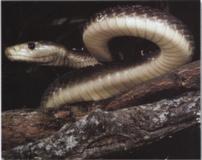

Genus: Dendroaspis
Species: polylepis

The Black Mamba is the most deadly snake in the world. They grow 14 feet in length, and can travel at speeds of up to 12 mph. They have a head shaped like a coffin. The Black Mamba is not actually black. They have a brownish-gray body with a light belly and brownish scales along its back. It gets its name from the color of the lining of its mouth, which is purple-black, and which it displays when threatened.
The Black Mamba lives in South Africa. They like open, low habitats such as savannas, rocky places and open woodlands. They are active during the day. They often sleep in hollow trees, burrows, rock crevices, or empty termite mounds, and will come back to the same place every night.
The Black Mambas feed on small mammals and birds, like voles, rats, squirrels, mice, rats, or bush babies. Once a Mamba was found with a parrot in its stomach, another with a full grown Forest Cobra! It will strike a large animal and then release it. It then stalks their victim until it becomes paralyzed. With smaller animals it will strike and hold on until the animal becomes paralyzed. Its flexible jaws and scales makes it possible to eat the animal whole.
Several weeks after a pair of mamba mate, the female will find a good place to lay 6-17 eggs. The burrow must be damp but not wet, and warm, but not too hot. After she lays her eggs the female leaves. The young snakes are about 16-24 inches long when they hatch three months later. They reach maturity when they are 3-4 feet in length.
The Black Mambas are found in pairs or small groups. They are very nervous, and head away fast when a human approaches. When the mamba feels threatened it will raise its front and head about 3-4 feet off the ground, open its mouth, spread a flat hood, and shake its head. When they attack they will make several quick strikes, and escape as fast as they can. They can strike from 4-6 feet away. Before antivenins were developed, a black mamba bite was 100% fatal.
They are invulnerable, because no animal can actually kill them. Their venom can kill just about anything, so they don't have much to worry about. The mamba is mainly threatened by habitat destruction.
by Allison F. 2000.
Bibliography:
"Index 206", http://www.bahnhof.se/~wizard/GLM/index206.htm
"Black Mamba General Info", http://www.kingsnake.com/mamba/gener.htm
"Black Mamba", Wildlife Explorer, USA: International Masters Publishers. 1999.